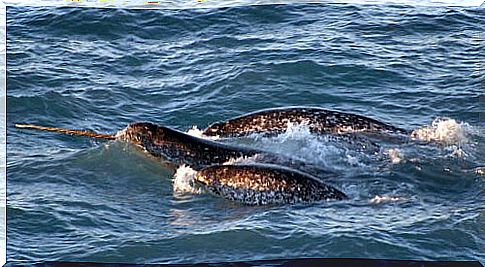The Narwhal: The Unicorn Of The Seas

It looks like a mythological being, but it is a real being that lives in our oceans. They call it the unicorn of the sea and it is difficult to study it; not all narwhals have their characteristic horn. The narwhal is a little known but exciting animal.
Narwhal characteristics
The narwhal is an ododenthus cetacean closely related to belugas, which means that it is a marine mammal that has teeth. It is part of the whale family and is characterized by a huge horn in front of its head, which is actually a tusk.
Males and females have slightly different bodies. As adults, males weigh an average of 1,600 kilograms and females reach 1,000 kilograms. A female is slightly smaller than a male: they measure around four meters, while they usually reach four and a half meters..
On the other hand, the narwhal changes color throughout its life. When they are born they are gray, and dark spots appear with a unique pattern for each one. These spots stop appearing when they are two years old, but they continue to grow over time, and it is that the oldest ones appear black: their spots have grown so much that they have completely covered them.
It differs from other whales in that it does not have a dorsal fin, a characteristic it shares with belugas. Instead, it has a crest that is up to a meter long.
Their most striking feature is the huge tusk that they have in front of their heads. This tusk can measure two meters and weigh more than 10 kilograms. It is unique in males, since females never develop it.
Until recently it was not known what the narwhal used its tusk for. It was believed that it was linked to orientation, and some scientists ventured to say that it was helped to break the thin ice. Recent research shows that the narwhal uses its tusk to hunt: it stuns fish by moving it very fast, so they can be eaten.
Behavior of the narwhal
The narwhal lives in small herds. During the winter they are made up of groups of two to nine individuals, but in the summer they migrate south and form huge herds of hundreds or thousands of narwhals.
It should be noted that narwhals are especially noisy cetaceans. Many of the other species of whales barely make sounds, but narwhals are not only constantly communicating by noise, they also have a great variety of them.
Thus, they produce clicks routinely and at different intervals; they are believed to use them for echolocation, just like dolphins. However, whistles and other sounds have been detected that are really only communication with other narwhals. They can modulate these sounds, which makes specialists think that they have a complex language.
On the other hand, and in relation to its diet, this animal gets its food on the seabed. It makes dives that last up to 30 minutes and is known to go up to 800 meters deep; so together with the sperm whale, it is one of the mammals that reaches the deepest depth when submerged.
Narwhal habitat
The narwhal is located in a very specific area of the planet. In winter it lives in the icy waters around the North Pole: northern Canada, around Greenland and in the northern part of the Atlantic Ocean in Russia. In summer it makes a small migration to the south and they have come to be seen in some fjords or in a Canadian inlet.
We know that they used to live in warmer waters, but with evolution they have moved to the coldest waters on the planet. They have a very limited habitat and, therefore, we know that their population is not very extensive. They are declared as an endangered species even though they hardly have any predators; only hunted by Inuit peoples.
Narwhal feeding
The narwhal feeds only on fish and crustaceans, making it a carnivorous animal. It can fish in schools of fish on the surface, but it is common for it to dive to feed on the creatures that inhabit the seabed.
It feeds especially when winter begins and the migration to the north has just finished, back to the colder waters. When there is hardly any ice in the waters in which it lives, it feeds very little or nothing; They can digest very slowly, causing the ingested prey to feed and nourish it for weeks or months.
The narwhal is another species of cetacean in danger of extinction, but luckily its protection is guaranteed. Although it is difficult to study and know them in depth, it seems that their population remains stable ; it does not have many dams and the greatest danger it has to survive is pollution.
It might interest you …
Image Source: Dr. Kristin Laidre, Polar Science Center










